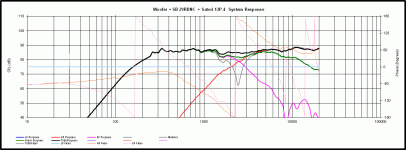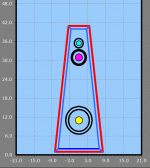My current thinking:
Tmw sealed enclosure.
Woofer: Aurum Cantus AC 250/75 c2c 10"
Mid: satori 5"
Tweeter: dayton ES soft dome
X-over points: 300, 2.4k hz.
f3: 58hz
Ok, let’s see if this will help you out.
For your tweeter, I was expecting very good things from the new Dayton but unfortunately, the FR is not very flat. The 1st chart below compares the ES (blue) against the SB Acoustics 29RDCN (red) that LineSource has already recommended. Low distortion above 2000Hz, low resonance frequency, low dome resonances, lots of SPL’s and a nice flat response. FR’s are from a baffle 7” x 17” x 43” with 1” edge chamfers. Tweeter at 37.5” from the bottom. No comparison really. The SB will be much easier to work with.
I like the change to the sealed 10” right next to the floor but I would reconsider the Aurum Cantus for your design. Three reasons:
1. It’s probably at least a very good woofer but the trouble with Aurum Cantus is that its specs can be more than a little off from reality. So not a good choice for a design by simulation.
2. Putting the woofer down at the floor level will essentially mean that from about 200Hz down, it will be back to playing in 2 pi space (if we don’t consider the walls) and so you won’t see the 6dB baffle step loss at those frequencies (2nd chart is axial floor gain with woofer 10” above the floor). We need to take this into account when matching driver sensitivities. Your design is actually going to share some similarities with Zaph’s SB12.3. Notice the sensitivity of the woofer and then notice exactly at what level the mids and tweeter end up at. There is basically no difference or in other words the design does not use any bsc (baffle step compensation). This means that for your speaker, the mid and tweeter sensitivity should also be about the same as your woofer sensitivity at a minimum (even if you don’t end up using all of it – I would start the design off at 3dB of bsc and then you’ll want to adjust by ear to suit your tastes and room). And here you have to make sure that you are comparing the same things: SPL at 1W/1m is not necessarily the same as at 2.83V/1m. The AC250 is rated at 90dB 1W/m but you’ll find that both the 4ohm and 8ohm Satori 5” end up at about 87dB 1W/m (as calculated by Unibox) so potentially not such a good match.
3. Low E on the bass is 42Hz and low C on the piano is 32Hz so I would try to get an F3 lower than 58Hz for music. At those LF’s, you need to ensure that room pressurization gain isn’t going to result in peaky, boomy bass and going sealed helps to achieve that (and is easier to work with and will give you better transient response). The 3rd chart below shows you what that gain will look like in a 25’ room with about 60% leakage (40-60% is average; they’ll be less gain in amplitude if the room has very thin walls, open doors or stairs or other areas, etc, and more gain if you live in a bunker with 6” concrete walls and sealed doors all around, or something similar) and then the 4th chart shows you the Aurum Cantus LF response compared against the ScanSpeak Classic 25W8565-00 and the SB Acoustics 29NRX75-6 (this one also previously recommended by LineSource) with the room gain added to each driver. F3 for the Scan (88dB 2.83V) is about 39Hz in 85L with heavy fill (Q=.567) and you get about 48Hz in 30L with heavy fill (Q=.645) for the SB29NRX (88dB 2.83V). The driver levels in the chart are also set to show you the maximum SPL for each driver before xmax is exceeded (which is when distortion starts to increase as the voice coil starts to come out of the magnetic gap) for content below 30Hz. I’ve added in the ScanSpeak driver a second time at the same level as the SB29 just so you can see exactly what the difference looks like between an F3 of 39Hz and 48Hz – I expect you’ll be able to hear a difference but it is actually smaller than what you might expect. So, tough decision here. In SQ terms, I’m not sure which is better. Maybe someone else has heard both of them. If high SPL, price and box size aren’t too much of a concern, then the Scan’s lower F3 wins out. But they’re small differences so maybe the SB is the better choice. Other opinions?
In terms of the mid: for your music and hi-end tastes, you’re going to want to look at some of the top tier drivers within your budget with sensitivity at or above about 88dB 2.83V, able to be crossed at or above about 2000Hz to work best with the tweeter and with a smooth FR when combined with your box’s diffraction response (5th chart below). I’d probably pick the following:
ScanSpeak Revelator 15W4531K00 - 4ohm 90dB 2.83V
Eton 5-200A8 88dB 1W/m
Satori 6.5" - 4ohm 90.5dB 2.83V
Satori 5" - 4ohm 89dB 2.83V
I still like the BG Neo10 and Neo8 for your application but the FR’s are far from flat and they don’t have TS parameters so not as easy to work with.
Chart 6 compares the Eton (blue) with the Scan 15W (red) on a 7” x 17” x 43” baffle with a 1” chamfer on the edges. Mid is 32” from the bottom. I like the Eton because of its very low distortion and because it’s got the smoothest response of all of the above mids which means it will probably be the easiest to work with. The Satoris have some kind of peaking somewhere between about 500Hz and 1500Hz or so that needs to be taken care of with some eq via a notch filter and perhaps a cone resonance peak up higher that also needs to be notched out for the Satori 6.5”. Means extra parts but either one isn’t really too difficult to implement. The rise in the response of the 15W above 1000Hz looks like it may be a problem but it’s actually quite easy to deal with with just the LP filter.
The problem with the Eton is that I haven’t seen a single person use it and that gives me pause. The Revelator on the other hand is a well known industry standard and one you can have complete confidence in. I use the 8ohm version myself with the Vifa XT25 tweeter in a 2-way. Very, very sweet.
The last chart compares the 2 Satori’s. (Btw in case you didn’t know, SB Acoustics who make Satori, is being run by the same gentleman who used to make all the ScanSpeaks. They are at that level of quality.) The 6.5” is blue and the 5” is the red one. Looking closely at the 5” driver, I’m a little perturbed by the suck out between 1500 and 1900Hz. Reports so far for the larger driver are that, subjectively, the null is a non-issue but the suckout is smaller on that one. One of the things I do like about these units besides their very low distortion is the very open magnet structure which helps to reduce immediate reflections back into the cone. I think the higher sensitivity, the smaller 1200Hz suckout and the narrower peaking gives the bigger Satori my vote. Crossover should be around 2000Hz (it’s crossed at 1850Hz in the well known Kairos) and that won’t be a problem for the SB tweeter.
One of the things you learn as you start to design xo’s is that certain drivers and their FR’s end up going together better than others but you may not be able to tell until you actually do the simulations. So what I suggest is picking some potential combinations and I can do some sims for you to see how they match up.
Attachments
-
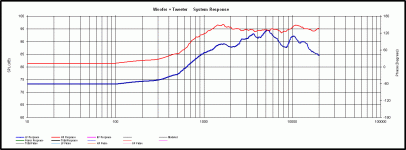 pic twtrs ES vs SB29.gif23 KB · Views: 254
pic twtrs ES vs SB29.gif23 KB · Views: 254 -
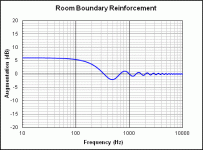 Pic flr gain 10in axial.gif12 KB · Views: 250
Pic flr gain 10in axial.gif12 KB · Views: 250 -
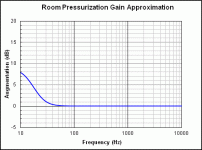 Pic rm gain 25ft 60%.gif11.5 KB · Views: 254
Pic rm gain 25ft 60%.gif11.5 KB · Views: 254 -
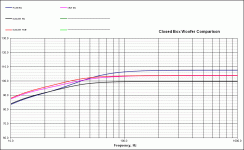 Pic woofer comparison.gif24.4 KB · Views: 255
Pic woofer comparison.gif24.4 KB · Views: 255 -
 Pic of BDS 7x17x43.GIF51.5 KB · Views: 251
Pic of BDS 7x17x43.GIF51.5 KB · Views: 251 -
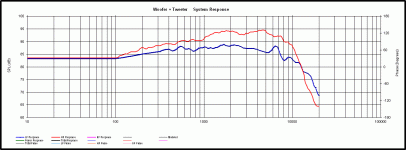 pic Eton 5 vs SS15W.gif23.5 KB · Views: 48
pic Eton 5 vs SS15W.gif23.5 KB · Views: 48 -
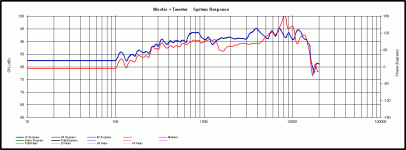 Pic Satori vs satori.gif25.9 KB · Views: 46
Pic Satori vs satori.gif25.9 KB · Views: 46
Hi,
Simple fact is my suggestion fits the original requested
requirements down to a tee, seems AOW simply doesn't
realise (or doesn't want to) how good a choice it would be.
The Sunflower Redux uses the RS225-8, not the 4.
I like this build version of it the most :
There no point repeating most of what has already been
said, if AOW wants to proceed with 3 drivers of his
choice, so be it, but very unlikely to do any better.
In terms of good design (what you do with the parts) I'd
say no chance of getting anywhere near the Sunflowers.
(FWIW proceeding on your own you will get as much bad
advice as good, and generally such things descend into a
mediocre consensus of a bunch of people agreeing with
each other about the simplistic basics of design and none
of the subtleties, i.e. your really on your own as to how well
its designed, somebody will agree with whatever you do.*)
I'm not suggesting an impending disaster, simply
not enough skill to pick well matched drivers and
combine them into something that will be near
their "best" use, and unequivocably justify the
spending of $1000 on drivers for a first build.
If a novice will not acccept that they are, and keeps
posting lists of drivers, there is not much you can do.
Destined to learn (or not) eventually the hard way ....
Despite all attempts to illuminate the better path ...
rgds, sreten.
* Except me of course, but in a thread the positivists
always outlast the naysayers, and they really think
that they are helping, and the naysayers give up,
as there is simply no point flogging a dead horse.
Simple fact is my suggestion fits the original requested
requirements down to a tee, seems AOW simply doesn't
realise (or doesn't want to) how good a choice it would be.
The Sunflower Redux uses the RS225-8, not the 4.
I like this build version of it the most :
An externally hosted image should be here but it was not working when we last tested it.
There no point repeating most of what has already been
said, if AOW wants to proceed with 3 drivers of his
choice, so be it, but very unlikely to do any better.
In terms of good design (what you do with the parts) I'd
say no chance of getting anywhere near the Sunflowers.
(FWIW proceeding on your own you will get as much bad
advice as good, and generally such things descend into a
mediocre consensus of a bunch of people agreeing with
each other about the simplistic basics of design and none
of the subtleties, i.e. your really on your own as to how well
its designed, somebody will agree with whatever you do.*)
I'm not suggesting an impending disaster, simply
not enough skill to pick well matched drivers and
combine them into something that will be near
their "best" use, and unequivocably justify the
spending of $1000 on drivers for a first build.
If a novice will not acccept that they are, and keeps
posting lists of drivers, there is not much you can do.
Destined to learn (or not) eventually the hard way ....
Despite all attempts to illuminate the better path ...
rgds, sreten.
* Except me of course, but in a thread the positivists
always outlast the naysayers, and they really think
that they are helping, and the naysayers give up,
as there is simply no point flogging a dead horse.
Last edited:
JReave: Thank you very much for your excellent responses and advice. I sent you a response already but somehow it did not get posted. And thank you for the drawing!
Because of your input please comment on the following:
I agree about Aurum Cantus because I found I was becoming skeptical of their posted information.
I recently acquired a used powered sub-woofer with a 10" sealed driver but I have not turned it on yet. (But it should work NIB). This can help with lower frequencies.
The dimensions I would like to work are 7" top, 16" bottom, 36" height. Center of woofer at 12" from the floor.
I like these SB drivers you mentioned. The 10" nrx and the 5" Nrx 4 ohm. These would be my current choice. And the tweeter choice you mentioned could be excellent!
I am thinking about an active x-over for the woofers and a passive for the mid/tweeter.
Do you think 300 hz and 2.4 k hz would be about right?
Thank you again and I will try to get my drawing program to work.
I would still consider the premium satori 5" if you think it is better than the Nrx.
Because of your input please comment on the following:
I agree about Aurum Cantus because I found I was becoming skeptical of their posted information.
I recently acquired a used powered sub-woofer with a 10" sealed driver but I have not turned it on yet. (But it should work NIB). This can help with lower frequencies.
The dimensions I would like to work are 7" top, 16" bottom, 36" height. Center of woofer at 12" from the floor.
I like these SB drivers you mentioned. The 10" nrx and the 5" Nrx 4 ohm. These would be my current choice. And the tweeter choice you mentioned could be excellent!
I am thinking about an active x-over for the woofers and a passive for the mid/tweeter.
Do you think 300 hz and 2.4 k hz would be about right?
Thank you again and I will try to get my drawing program to work.
I would still consider the premium satori 5" if you think it is better than the Nrx.
Last edited:
I think the other problem with this is you are not designing a speaker. Others are making suggestions that appeal to your tastes. Are they designing the speaker for you? Everything including final voicing? Likewise, the others you do accept suggestions from have overlooked drivers that are reference quality, but from a manufacture that has already been dismissed. To me that speaks volumes, but how would you know difinitively?
While I haven't a problem with resolving issues in a design, from scratch not interested because it is impossible.
Regardless I do wish you the best in this endeavor.
While I haven't a problem with resolving issues in a design, from scratch not interested because it is impossible.
Regardless I do wish you the best in this endeavor.
If you have a sub that you are happy with for music and have a means of implementing a HP xo on the mains (like a home theater AVR), that will change things considerably. With a sub handling from 20-80Hz or so, you no longer have any need for 2 x 10" woofers in your mains to be handling the same frequencies. With a sub, a 2-way (or 3-way if you prefer) that gets you down to somewhere around 60-80Hz is going to be more than adequate. In that case, it really makes a lot more sense to go for a proven high-end design like the Kairos or the Adelphos that use the Satori 6.5" or one of the numerous designs using a Scan 15W like the Carreras. The other very well regarded 2-way that comes to mind are the Continuums, which use the Aurum Cantus AC130F1* and are an amazing value for what they achieve.
If you are still set on your own 3-way design with a sub, then you could easily go back to your 1st woofer choice using the Dayton ES180 in a small sealed box for an F3 around 70Hz. You can match this now with a smaller mid, say 3"-5", and potentially a different tweeter with a higher xo point, so a ribbon tweeter for example.
Maybe I have misconstrued the level of SQ you are after, but I have not suggested the SB15NRX for you. A very high value driver but it is not quite at the level of the other drivers I've listed. If you want to go for that level of SQ, you might as well take sreten's advice and go with the Sunflowers. Perhaps seal up the woofer or plug the port anyway if using the sub and make sure you have more like 3' or so instead of 1.5' from the front wall to the front baffle for the Sunflowers' OB mid implementation.
* Greebster, if this was the driver you were referring to in your last post that I dismissed, I would definitely have included it in my higher end recommendations except its sensitivity was too low to match up to the 10" woofers sitting down at floor level. Going with a sub negates that requirement and so it now ends up on the recommended list.
If you are still set on your own 3-way design with a sub, then you could easily go back to your 1st woofer choice using the Dayton ES180 in a small sealed box for an F3 around 70Hz. You can match this now with a smaller mid, say 3"-5", and potentially a different tweeter with a higher xo point, so a ribbon tweeter for example.
Maybe I have misconstrued the level of SQ you are after, but I have not suggested the SB15NRX for you. A very high value driver but it is not quite at the level of the other drivers I've listed. If you want to go for that level of SQ, you might as well take sreten's advice and go with the Sunflowers. Perhaps seal up the woofer or plug the port anyway if using the sub and make sure you have more like 3' or so instead of 1.5' from the front wall to the front baffle for the Sunflowers' OB mid implementation.
* Greebster, if this was the driver you were referring to in your last post that I dismissed, I would definitely have included it in my higher end recommendations except its sensitivity was too low to match up to the 10" woofers sitting down at floor level. Going with a sub negates that requirement and so it now ends up on the recommended list.
The dimensions I would like to work are 7" top, 16" bottom, 36" height. Center of woofer at 12" from the floor.
I am thinking about an active x-over for the woofers and a passive for the mid/tweeter.
Do you think 300 hz and 2.4 k hz would be about right?
What height are your ears at in your listening position? This is usually the height that the tweeter needs to be at as well. Usually about 38"/39" for most people and couches which means a 36" cabinet height is most likely too low. But your situation could be different.
Cabinet design and driver placement are not simply done for reasons of aesthetics btw. You need to work with the 2 together plus the edge treatment to achieve a baffle diffraction response for each driver (well primarily for the tweeter and the mid) that will combine well with the drivers you are considering. I've been finding 5" or 6" down from the top of the cabinet for the ceneter of the tweeter to be producing the flattest responses with your cabinet dimensions.
Try the Baffle Diffraction Simulator if you want to see this for yourself. You'll need Excel though. It's also got a bit of a steep learning curve. Let me know if you need a quick walk through.
Going active + passive can work but will require a 2nd amp, or a 2nd set of amp channels to be more precise. It may make things easier for you although going active isn't a magic elixir - you still need to design the xo and measurements may end up being just as needful in the end as with a passive xo.
Those xo points seem reasonable for the TMW design we've been discussing but it's a novice's mistake to try to set them in stone before the simulation phase. There are more than a few things that need line up properly for good xo implementation and you sort of have to just let the drivers decide where they want to be best crossed over in the end.
jReave: Thank you for your timely response. The sub-woofer is a recent thing but I think it is best served from 20-75 and of course the room integration issues. I would cross over to the mains at 55.
I would really like to achieve a stereo music oriented sound which emphasizes sound quality over loudness, extreme detail or bass extension. I was researching these drivers before your last response. I understand the nrx series is not the same quality as the Satori series. Even with the dip in the frequency response I would try to use this Satori 5" 4 ohm driver. I also like the the tweeter recommendation you made. Presumably the sensitivities can be adjusted. It is the woofer that is the hardest. The limiting factor for me is the volumes required for the woofer. I now understand that the sealed approach requires a low Fs and an appropriate Qts like .27. Then the volume is like 36 liters as opposed to 80 liters.
I guess I am striving for low distortion, and favorable phase and group delay characteristices. The mid-high x-over choice that favors this would be preferable. (LR2?).
The active x-over would improve the woofer to mid sensitivity issue and take this out of the passive circuit. This 10" woofer approach provides F3=48 and others, like the 7" dayton are in the high 60's. I have suitable power amplifiers for this.
So a question would be what steps do you recommend to assess the suitability of the SB tweeter and the Satori 5" with a favorable LR2 crossover?
I do not understand why the Sunflowers speaker is in anyway suitable for this project. It is an open back design which is not suitable for this location. Any the Tarkus design looks like a rock speaker.
Thank you.
I would really like to achieve a stereo music oriented sound which emphasizes sound quality over loudness, extreme detail or bass extension. I was researching these drivers before your last response. I understand the nrx series is not the same quality as the Satori series. Even with the dip in the frequency response I would try to use this Satori 5" 4 ohm driver. I also like the the tweeter recommendation you made. Presumably the sensitivities can be adjusted. It is the woofer that is the hardest. The limiting factor for me is the volumes required for the woofer. I now understand that the sealed approach requires a low Fs and an appropriate Qts like .27. Then the volume is like 36 liters as opposed to 80 liters.
I guess I am striving for low distortion, and favorable phase and group delay characteristices. The mid-high x-over choice that favors this would be preferable. (LR2?).
The active x-over would improve the woofer to mid sensitivity issue and take this out of the passive circuit. This 10" woofer approach provides F3=48 and others, like the 7" dayton are in the high 60's. I have suitable power amplifiers for this.
So a question would be what steps do you recommend to assess the suitability of the SB tweeter and the Satori 5" with a favorable LR2 crossover?
I do not understand why the Sunflowers speaker is in anyway suitable for this project. It is an open back design which is not suitable for this location. Any the Tarkus design looks like a rock speaker.
Thank you.
Ok, that helps me understand what your goals are for your system.
Agreed on the Sunflowers and the Tarkus - I didn't think they would fit your preferences.
Don't worry about the mid/tweeter xo right now - leave that to me. In fact I think you'll be fine with a fully passive set-up but that's up to you. Again, do not lock yourself into a xo order prior to simulations. It's the acoustic slope and phase that we want to get right and often that works out to a 2nd order electrical on the mid and a 3rd order electrical on the tweeter, but that can depend as well on the relative positions of the drivers' acoustic centers and that can be varied depending on what you do with the baffles, but now I'm getting ahead of myself.
Re-setting the required F3 from down around 40Hz to something like 55Hz means that we don't really need to go with a 10" woofer anymore (although you can if you want), 8" will work fine because you no longer need the extra surface area and/or xmax in order to dig down to 40Hz. In fact with a HP xo on the woofer now, you're going to find that exceeding xmax will no longer be a consideration at all. Instead the woofer will be power limited in terms of max SPL's and 1. you're not that interested in serenading the whole neighborhood, and 2. even if you were, an 8" will usually be able to take lots of power.
Try looking at these:
Eton 8-402/C8/32 88dB 1W/m F3=47Hz in 40L Q=.703 Those are almost Accuton-like distortion levels between 90-300Hz which is exactly where you'll be using them. I'm impressed. $250
ScanSpeak Classic 21W8555-00 87dB 2.83V/m F3=54Hz in 25L Q=.626 $250 at Solen. $154 at Meniscus. That's a deal even with the duties and the low Cnd dollar right now.
SB 23NACS45-8 87.5dB 2.83V/m F3=53Hz in 30L Q=.634 $115
Anyone of those looks like it'll be a good match with the 5" satori, even with a passive xo. Again, I would sim to make sure though.
Agreed on the Sunflowers and the Tarkus - I didn't think they would fit your preferences.
Don't worry about the mid/tweeter xo right now - leave that to me. In fact I think you'll be fine with a fully passive set-up but that's up to you. Again, do not lock yourself into a xo order prior to simulations. It's the acoustic slope and phase that we want to get right and often that works out to a 2nd order electrical on the mid and a 3rd order electrical on the tweeter, but that can depend as well on the relative positions of the drivers' acoustic centers and that can be varied depending on what you do with the baffles, but now I'm getting ahead of myself.
Re-setting the required F3 from down around 40Hz to something like 55Hz means that we don't really need to go with a 10" woofer anymore (although you can if you want), 8" will work fine because you no longer need the extra surface area and/or xmax in order to dig down to 40Hz. In fact with a HP xo on the woofer now, you're going to find that exceeding xmax will no longer be a consideration at all. Instead the woofer will be power limited in terms of max SPL's and 1. you're not that interested in serenading the whole neighborhood, and 2. even if you were, an 8" will usually be able to take lots of power.
Try looking at these:
Eton 8-402/C8/32 88dB 1W/m F3=47Hz in 40L Q=.703 Those are almost Accuton-like distortion levels between 90-300Hz which is exactly where you'll be using them. I'm impressed. $250
ScanSpeak Classic 21W8555-00 87dB 2.83V/m F3=54Hz in 25L Q=.626 $250 at Solen. $154 at Meniscus. That's a deal even with the duties and the low Cnd dollar right now.
SB 23NACS45-8 87.5dB 2.83V/m F3=53Hz in 30L Q=.634 $115
Anyone of those looks like it'll be a good match with the 5" satori, even with a passive xo. Again, I would sim to make sure though.
Agreed on the Sunflowers and the Tarkus - I didn't think they would fit your preferences.
Hi,
The Tarkus doesn't, but the Sunflower does to a tee.
"small scale with emphasis on voice and the midrange."
If a sub is involved, it can be easily built sealed to good effect.
The x/o is ~ LR2 bass/mid and ~ LR4 mid/treble acoustic.
rgds, sreten.
Last edited:
I do not understand why the Sunflowers speaker is in anyway suitable for
this project. It is an open back design which is not suitable for this location.
Hi,
It beats me as to why you think its major design feature is unsuitable.
"small scale with emphasis on voice and the midrange."
That is what it does, which is why I'm suggesting it. I
don't see any issues with locating it, its not a full dipole.
However I'm not going to attempt to justify it any
further, you seem to think it does things it probably
doesn't, and if your not excited by the design, then
simply don't build it, due to an a priori attitude.
Yes the Tarkus would suck for your application,
(only relatively, its not a bad speaker), but
IMO the the Sunflowers wouldn't at all.
An alternative is a 3.5 way such as :
zaph|audio - zdt3.5
Which again is a different take on a typical mid
/treble 3 way, having an unusually smooth
power response in the mid and vocal region,
and uses the best ranges of the drivers well.
Another design that has relatively "unusual"
midrange and is highly unlikely to dissapoint.
Its very well documented, and with some further simming
could be persuaded into a trapezoidal cabinet, and/or even
an active version, simplifying the x/o quite a lot.
To put it bluntly a novice can't design anything that
puts SQ above all other issues, thats blowing smoke.
SQ is all about balancing all the other issues, with
experience, and very good design skills/methods.
Like the two designs above.
rgds, sreten.
Last edited:
To jReave: great work. With respect to the speaker height: I was trying to get the tweeter at ear level with spikes. I could be off a little. I could go with 100 cm (approximately 40" plus spikes).
I vote for the Eton. It looks wonderful. Perfect. Makes the design easier as well.
Again, thank you.
So 8" Eton, 5" Satori 4 ohm and the SB tweeter. progress!
"Not failure but low aim is crime." --Cicero.
I vote for the Eton. It looks wonderful. Perfect. Makes the design easier as well.
Again, thank you.
So 8" Eton, 5" Satori 4 ohm and the SB tweeter. progress!
"Not failure but low aim is crime." --Cicero.
Last edited:
Sounds good for the drivers. Maybe think about your 2nd choices just in case, although my 1st attempt on the Satori + SB29 xo went better than I expected (see 1st chart below). Still needs work though. That's with 3rd order electric and acoustic on both the mid and tweeter. Xo is at about 2500Hz. I've got a series notch filter placed in parallel on the mid to pull down the peaking response between about 650Hz and 1500Hz (actually it's more like 2 peaks and I'm contemplating using 2 notch filters) and a tanking filter on the mid as well (which is just an extra capacitor with the main inductor) to kill its 8000Hz cone resonance. Phase is aligning very well.
Next though you need to finalize the baffle dimensions and layout for me. 40" high is better. The 2nd picture below is for a 7" x 16" x 40" cabinet with the center of the woofer 10" from the bottom, 30" for the mid and 34.5" for the tweeter with a 1" 45* chamfer along the edges (you can skip the bottom edge if you want, that one's not that important). The tweeter positioning and the chamfer are a must however for a nice flat response from the tweeter. The mid can be moved a bit and the woofer you can actually put wherever it fits but down by the floor gives you some extra output in the 100Hz to about 250Hz zone which often gets shortchanged due to boundary effects.
Getting the cab up another inch or 2 sounds like a good idea but you can also give it a little backwards tilt to aim the tweeter more directly at your ears. One or both of those should do the trick.
For drivers of this quality, you are going to want to build an equally good cabinet. Let me know if you want any info on that although you should be forewarned that there are more than a few schools of thought on how to do that and so not a lot of agreement. I would consider possibly splitting the cab into 2 sections (TM + W) or employing some kind of strategy on the baffle for isolating the TM from the woofer's vibrations. Also consider keeping the xo external by mounting it to the underside of the cab. Look at Troel's site again for ideas - he does a really good job with his xo's and cabinets.
Next though you need to finalize the baffle dimensions and layout for me. 40" high is better. The 2nd picture below is for a 7" x 16" x 40" cabinet with the center of the woofer 10" from the bottom, 30" for the mid and 34.5" for the tweeter with a 1" 45* chamfer along the edges (you can skip the bottom edge if you want, that one's not that important). The tweeter positioning and the chamfer are a must however for a nice flat response from the tweeter. The mid can be moved a bit and the woofer you can actually put wherever it fits but down by the floor gives you some extra output in the 100Hz to about 250Hz zone which often gets shortchanged due to boundary effects.
Getting the cab up another inch or 2 sounds like a good idea but you can also give it a little backwards tilt to aim the tweeter more directly at your ears. One or both of those should do the trick.
For drivers of this quality, you are going to want to build an equally good cabinet. Let me know if you want any info on that although you should be forewarned that there are more than a few schools of thought on how to do that and so not a lot of agreement. I would consider possibly splitting the cab into 2 sections (TM + W) or employing some kind of strategy on the baffle for isolating the TM from the woofer's vibrations. Also consider keeping the xo external by mounting it to the underside of the cab. Look at Troel's site again for ideas - he does a really good job with his xo's and cabinets.
Attachments
jReave: The drawing looks good. I think to have separate cabinets is a good idea. So for the TM upper cabinet we can just take the top 13" inches with a 7" top and 10" bottom for our dimensions. This is the most important physical aspect of the design. What do you think of a wave guide for the tweeter? (physical alignment and diffraction reduction).
For diffraction the wave guide could help (if done right), the face contouring will help and maybe felt.
For diffraction the wave guide could help (if done right), the face contouring will help and maybe felt.
I don't think a waveguide is needed with this tweeter but more importantly, I can't simulate its response so using one means that measurements are absolutely required.
Be sure that 13" of height isn't too tight against the bottom of the mid. Maybe another inch or so is needed? And it will depend on how thick your cabinet walls are going to be. There are at least 2 strategies for mid cabs: push the resonances below the mid's frequency range with 1/2" BB plywood with no bracing and lots of damping or push it up higher into the passband where there isn't enough energy to make very stiff and heavy walls vibrate, so 2 layers of plywood plus bracing. I would add wall damping too. And insulation in both.
One nice thing about the separate cabs is that you can move the top cab backwards relative to the bottom cab so that the acoustic centers of the mid and woofer line up better. My sims are suggesting this would be a good idea. That's if you want to go with passive xo's on the mid/woofer. So place the front of the top cab right where the 1 inch chamfer of the bottom cab ends.
Be sure that 13" of height isn't too tight against the bottom of the mid. Maybe another inch or so is needed? And it will depend on how thick your cabinet walls are going to be. There are at least 2 strategies for mid cabs: push the resonances below the mid's frequency range with 1/2" BB plywood with no bracing and lots of damping or push it up higher into the passband where there isn't enough energy to make very stiff and heavy walls vibrate, so 2 layers of plywood plus bracing. I would add wall damping too. And insulation in both.
One nice thing about the separate cabs is that you can move the top cab backwards relative to the bottom cab so that the acoustic centers of the mid and woofer line up better. My sims are suggesting this would be a good idea. That's if you want to go with passive xo's on the mid/woofer. So place the front of the top cab right where the 1 inch chamfer of the bottom cab ends.
Hi,
1" of alignment between a bass and mid is nonsense, and easily
accounted for in the acoustic responses by slight assymetry.
If considering waveguides consider the Seas DXT or simply
don't bother with wave guides for such a small midrange.
(Well you can, if you like biting off a lot more than you can chew.)
Arguably the best approach to a mid/treble cabinet
is a floating cabinet within a cabinet, a dual layer.
BSC cannot be ignored realistically, it will apply to the mid.
rgds, sreten.
1" of alignment between a bass and mid is nonsense, and easily
accounted for in the acoustic responses by slight assymetry.
If considering waveguides consider the Seas DXT or simply
don't bother with wave guides for such a small midrange.
(Well you can, if you like biting off a lot more than you can chew.)
Arguably the best approach to a mid/treble cabinet
is a floating cabinet within a cabinet, a dual layer.
BSC cannot be ignored realistically, it will apply to the mid.
rgds, sreten.
Last edited:
A project that has been deliberated as the way it is, you cannot modify it.
It's got to have the same speakers, the same crossover and the same enclosure. If you want to change minor things, such as the woofer ( minor...!!), it'll become the Sunflowers with a different woofer- and a different lowpass ( not-the-same-component-values).
DSP is another matter at all and difference between an active version vs passive and "targeting the slopes" has been discussed over and over in this forum.
It's got to have the same speakers, the same crossover and the same enclosure. If you want to change minor things, such as the woofer ( minor...!!), it'll become the Sunflowers with a different woofer- and a different lowpass ( not-the-same-component-values).
DSP is another matter at all and difference between an active version vs passive and "targeting the slopes" has been discussed over and over in this forum.
The drivers are available in the UK but not at US prices. The UK now has a Dayton distributor although I got no response when I asked about pricing. Perhaps you will have better luck or you can buy from Intertechnik.I'm going to take the advice given by Sreten here and build the Sunflower as my first speaker. Two questions, what drivers can I use that are available in the UK and could I use a MiniDSP as a crossover to start with?
MiniDSP is a more expensive but a more flexible choice.
You are aware that these are open back speakers and the issues this causes such as where they need be sited in the room and how the sound is different from "standard". There are good reasons almost no commercial speakers are like this.
- Status
- This old topic is closed. If you want to reopen this topic, contact a moderator using the "Report Post" button.
- Home
- Loudspeakers
- Multi-Way
- Advice for novice speaker builder.
